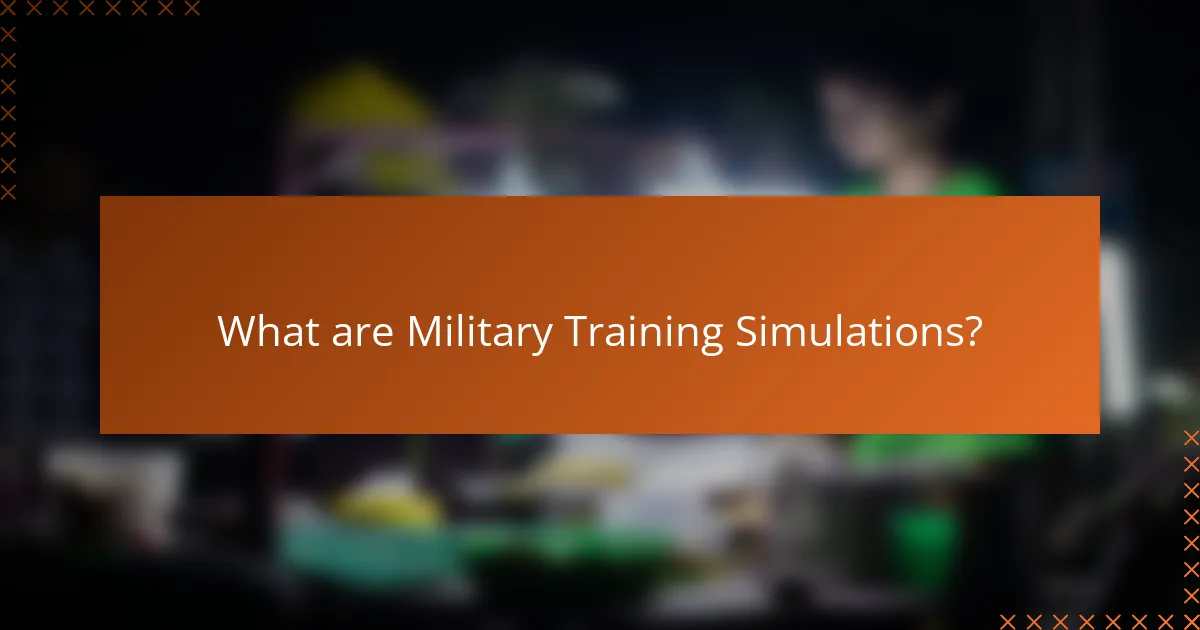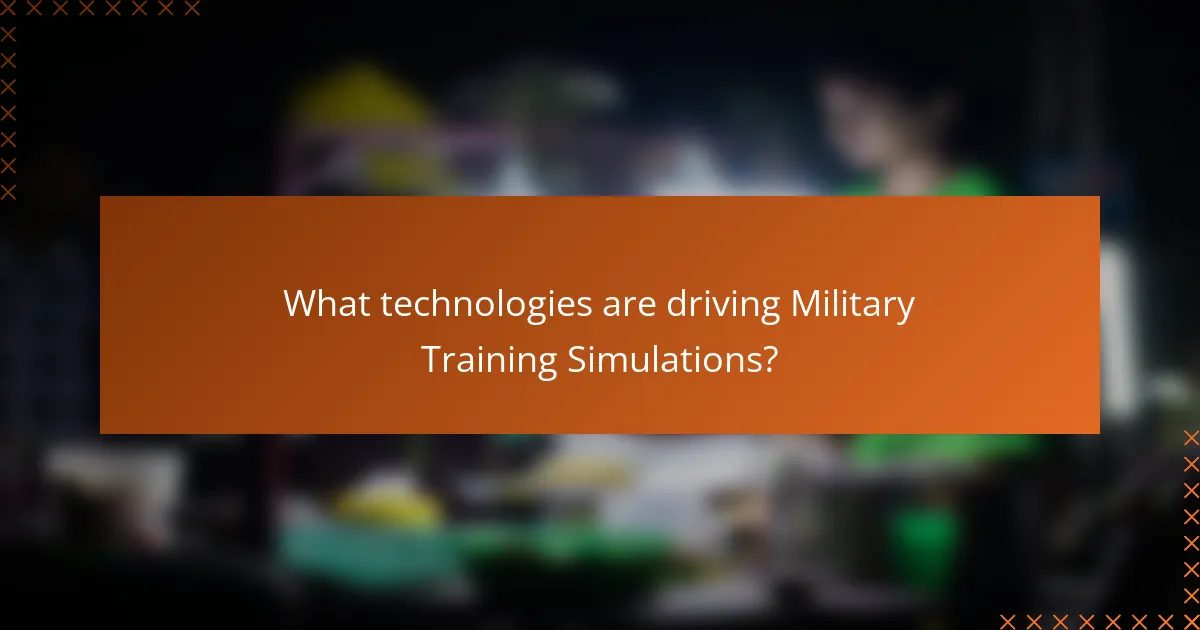Military training simulations are advanced technologies designed to replicate combat scenarios for the training of military personnel. These simulations utilize tools like virtual reality (VR), augmented reality (AR), and artificial intelligence (AI) to create realistic environments that enhance skills such as teamwork, communication, and strategic planning. The article explores the evolution of these simulations, highlighting their benefits in improving operational readiness and effectiveness. It also examines future trends, including the increasing integration of AI and cloud-based systems, which facilitate remote training and personalized learning experiences. Overall, the advancements in military training simulations aim to optimize training efficiency and effectiveness.

What are Military Training Simulations?
Military training simulations are advanced technologies used to replicate combat scenarios for training purposes. They provide realistic environments where military personnel can practice tactics and decision-making. These simulations can range from computer-based programs to virtual reality systems. They allow for safe training without the risks associated with live exercises. Military training simulations enhance skills like teamwork, communication, and strategic planning. They are widely used in various branches of the military. Studies indicate that these simulations improve readiness and effectiveness in real-world operations.
How have Military Training Simulations evolved over time?
Military training simulations have evolved significantly over time. Initially, they relied on basic physical exercises and live drills for training. The introduction of simulators in the 1960s marked a shift towards more realistic training environments. These early simulators used analog technology to mimic combat scenarios.
By the 1980s, computer-based simulations emerged, offering advanced graphics and interactivity. This allowed for more complex scenarios and better decision-making training. The 1990s saw the rise of virtual reality (VR) technology, enhancing immersion in training exercises. Modern military simulations now incorporate artificial intelligence and real-time data analysis.
These advancements enable personalized training experiences and adaptive learning. Current simulations can replicate diverse environments and situations, improving readiness. The integration of multi-user platforms allows for joint training among different military branches. Overall, military training simulations have transitioned from simple drills to sophisticated, technology-driven systems.
What historical milestones have shaped Military Training Simulations?
The development of military training simulations has been shaped by several historical milestones. The introduction of flight simulators in the 1920s marked the beginning of simulation technology in military training. The U.S. Army’s use of the Army Battle Command System in the 1980s advanced tactical training through computer simulations. The Gulf War in the early 1990s highlighted the need for realistic training environments. The development of virtual reality technology in the late 1990s provided immersive training experiences. The integration of artificial intelligence in the 2000s allowed for adaptive training scenarios. The rise of online multiplayer simulations in the 2010s facilitated collaborative training across distances. Each of these milestones contributed to the evolution and effectiveness of military training simulations.
What role did technology play in the evolution of Military Training Simulations?
Technology has been pivotal in the evolution of military training simulations. It has enabled the development of advanced simulation environments that replicate real-world scenarios. Virtual reality and augmented reality technologies have transformed training experiences, allowing for immersive learning. These technologies provide realistic feedback and enhance decision-making skills. Computer-based simulations have increased accessibility and scalability of training programs. Data analytics has improved performance assessment and personalized training pathways. Additionally, artificial intelligence has facilitated adaptive learning systems that respond to individual trainee needs. Overall, technology has significantly enhanced the effectiveness and efficiency of military training simulations.
What types of Military Training Simulations exist today?
There are several types of military training simulations today. These include live simulations, virtual simulations, and constructive simulations. Live simulations involve real personnel and equipment in a controlled environment. Virtual simulations utilize computer-generated environments for training purposes. Constructive simulations focus on modeling and simulating scenarios without real-time interaction. Each type serves unique training objectives. For example, live simulations enhance teamwork and coordination. Virtual simulations allow for safe, repeatable training scenarios. Constructive simulations enable complex scenario planning and analysis. These methodologies reflect advancements in technology and training strategies.
What are the key features of virtual simulations?
Key features of virtual simulations include immersive environments, interactive scenarios, and real-time feedback. Immersive environments replicate real-world settings, enhancing realism. Interactive scenarios allow users to engage with the simulation actively. Real-time feedback provides immediate insights into performance and decision-making. Additionally, virtual simulations support scalability, enabling training for individuals or large groups. They also facilitate safe training experiences without physical risks. Lastly, data analytics can track performance metrics for continuous improvement. These features collectively enhance training effectiveness in military contexts.
How do live simulations differ from constructive simulations?
Live simulations involve real personnel and equipment in actual environments. Constructive simulations, on the other hand, use computer-generated entities and scenarios. Live simulations provide real-time feedback and interaction among participants. Constructive simulations offer flexibility in scenario design and can simulate large-scale operations. Live simulations emphasize physical presence and realism. Constructive simulations allow for complex modeling and analysis without physical constraints. Both types serve distinct training purposes in military contexts.
What benefits do Military Training Simulations provide?
Military training simulations provide enhanced realism in training environments. They allow personnel to practice complex scenarios without real-world risks. Simulations can be tailored to specific missions or environments, improving preparedness. They also offer immediate feedback on performance, allowing for targeted improvement. Cost savings are significant compared to traditional training methods. According to a study by the U.S. Army Research Laboratory, simulations reduce training costs by up to 50%. Additionally, they support collaborative training among units, fostering teamwork. Overall, military training simulations are crucial for effective and efficient military readiness.
How do Military Training Simulations enhance combat readiness?
Military training simulations enhance combat readiness by providing realistic, immersive training environments. These simulations allow soldiers to practice tactical maneuvers without the risks associated with live training. They improve decision-making skills under pressure by replicating high-stress combat scenarios. Simulations can be tailored to specific missions, enhancing relevance and effectiveness. Data collected during simulations offers insights into individual and team performance. This feedback enables targeted improvements in tactics and strategies. Research shows that soldiers who engage in simulation training demonstrate better performance in real-world situations. A study by the U.S. Army Research Institute found that simulation training can increase mission success rates by 20%.
What cost savings are associated with using Military Training Simulations?
Military training simulations provide significant cost savings by reducing the need for physical resources. These simulations eliminate expenses related to fuel, maintenance, and wear on real equipment. Training in virtual environments also decreases the costs of travel and accommodation for personnel. Additionally, simulations allow for repeated training scenarios without incurring extra costs. According to a study by the U.S. Army, using simulations can save up to 30% in training costs compared to traditional methods. Overall, military training simulations offer an economically efficient alternative to conventional training practices.

What technologies are driving Military Training Simulations?
Virtual reality (VR) and augmented reality (AR) are key technologies driving military training simulations. VR immerses users in a fully digital environment, enhancing realism. AR overlays digital information onto the real world, aiding situational awareness. Simulation software utilizes advanced algorithms to create realistic scenarios. Artificial intelligence (AI) enhances decision-making and adapts training based on performance. High-fidelity graphics improve visual representation of environments and equipment. Motion tracking technology captures user movements for accurate interaction. These technologies collectively enhance training effectiveness and operational readiness.
How is virtual reality utilized in Military Training Simulations?
Virtual reality is utilized in military training simulations to create immersive training environments. These simulations allow soldiers to experience realistic scenarios without the risks associated with live training. Virtual reality enhances skill development in areas such as weapon handling, tactical decision-making, and teamwork. Training can be tailored to specific missions or environments, improving relevance and effectiveness. Studies show that VR training can lead to better retention of skills compared to traditional methods. The technology also facilitates after-action reviews, enabling soldiers to analyze their performance in real-time. Overall, virtual reality significantly enhances the quality and safety of military training.
What are the advantages of using virtual reality in training?
Virtual reality (VR) in training offers immersive experiences that enhance learning. It allows trainees to engage in realistic scenarios without real-world risks. VR can simulate high-pressure environments, improving decision-making skills. Studies show that VR training can increase retention rates by up to 75%. This method also accommodates various learning styles, catering to visual, auditory, and kinesthetic learners. Additionally, VR training can be conducted remotely, reducing costs associated with physical training environments. The technology allows for immediate feedback, enabling quick adjustments in learning strategies. Overall, VR in training significantly boosts effectiveness and engagement.
How does augmented reality complement Military Training Simulations?
Augmented reality enhances military training simulations by providing immersive and interactive experiences. It overlays digital information onto the real world, allowing trainees to visualize complex scenarios. This technology enables realistic battlefield simulations without the risks associated with live training. AR can simulate various environments and conditions, enhancing adaptability and decision-making skills. Research shows that AR can improve retention rates in training by up to 75%. The integration of AR in military simulations allows for real-time feedback, enabling immediate adjustments to tactics and strategies. This approach fosters a more engaging and effective learning environment for soldiers.
What role does artificial intelligence play in Military Training Simulations?
Artificial intelligence enhances military training simulations by providing adaptive learning environments. AI algorithms analyze trainee performance in real-time. This allows for personalized feedback and targeted skill development. Simulations can mimic unpredictable battlefield scenarios using AI. This prepares soldiers for various combat situations. AI also streamlines resource management within training exercises. It optimizes logistics and ensures efficient use of assets. Studies show that AI-driven simulations improve training outcomes significantly. This leads to better preparedness and decision-making in real-world missions.
How does AI improve decision-making in training scenarios?
AI enhances decision-making in training scenarios by providing data-driven insights. It analyzes vast amounts of data from past training exercises. This analysis helps identify patterns and trends in performance. AI can simulate various scenarios and outcomes in real-time. This allows trainees to experience diverse situations without real-world consequences. Additionally, AI personalizes training based on individual performance metrics. A study by the U.S. Army Research Laboratory demonstrated that AI-driven simulations improved trainees’ decision-making speed by 30%. AI also facilitates feedback by assessing actions taken during simulations. This creates opportunities for immediate learning and adaptation.
What are the potential challenges of integrating AI into Military Training Simulations?
Integrating AI into military training simulations presents several potential challenges. One significant challenge is the need for substantial data to train AI models effectively. Military operations generate vast amounts of data, but not all of it is structured or easily accessible. This can hinder the development of accurate AI systems.
Another challenge is the complexity of simulating real-world scenarios. AI must account for numerous variables, including human behavior and unpredictable events. This complexity can lead to difficulties in creating realistic training environments.
Moreover, there are concerns about the reliability and accountability of AI systems. Errors in AI decision-making can have serious consequences in military contexts. Ensuring that AI systems are robust and trustworthy is essential.
Additionally, integrating AI requires significant investment in technology and training. Military personnel must be educated on AI capabilities and limitations. This training can be resource-intensive and time-consuming.
Lastly, ethical considerations arise when using AI in military training. Issues such as bias in AI algorithms and the potential for misuse must be addressed. These ethical challenges complicate the integration process and require careful consideration.

What future trends can we expect in Military Training Simulations?
Future trends in military training simulations include increased use of artificial intelligence and virtual reality. These technologies enhance realism and adaptability in training scenarios. AI can create dynamic environments that respond to trainee actions. Virtual reality offers immersive experiences that improve skill retention. Additionally, cloud-based simulations allow for remote training and collaboration. This trend enables access to training resources from various locations. Enhanced data analytics will provide insights into trainee performance. These insights can inform personalized training pathways. Overall, these advancements aim to improve efficiency and effectiveness in military training.
How will advancements in technology impact Military Training Simulations?
Advancements in technology will significantly enhance military training simulations. Technologies such as virtual reality (VR) and augmented reality (AR) create immersive training environments. These environments allow soldiers to experience realistic combat scenarios without physical risks. Artificial intelligence (AI) can analyze performance and provide personalized feedback to trainees. Additionally, data analytics can optimize training programs based on individual needs and performance metrics. High-fidelity simulations increase engagement and improve retention of skills. The integration of advanced technologies leads to more effective and efficient training processes. This evolution is supported by studies showing increased readiness and adaptability in military personnel.
What emerging technologies are on the horizon for Military Training Simulations?
Emerging technologies on the horizon for military training simulations include virtual reality (VR), augmented reality (AR), and artificial intelligence (AI). VR provides immersive training experiences that enhance realism. AR overlays digital elements onto the real world, improving situational awareness. AI can create adaptive training scenarios tailored to individual needs. These technologies are being integrated into programs to simulate complex combat environments. The U.S. Army’s Synthetic Training Environment is an example of this integration. It aims to provide a unified training experience using these advanced technologies.
How might the integration of big data and analytics enhance training outcomes?
The integration of big data and analytics can significantly enhance training outcomes. It enables personalized learning experiences tailored to individual needs. By analyzing performance data, trainers can identify strengths and weaknesses in real-time. This allows for immediate adjustments to training programs. Furthermore, big data can predict future performance trends based on historical data. A study by the University of Southern California found that data-driven training approaches can improve retention rates by up to 30%. Analytics also helps in resource allocation, ensuring that training resources are used efficiently. Overall, big data and analytics provide actionable insights that lead to improved training effectiveness.
What are the implications of these trends for military training strategies?
The implications of trends in military training simulations include enhanced realism and adaptability. These advancements allow for more effective training scenarios that mimic real-world conditions. Increased use of virtual reality (VR) and augmented reality (AR) technologies enables soldiers to experience immersive environments. This leads to improved decision-making skills under pressure. Additionally, data analytics can track individual performance and provide tailored feedback. This personalization enhances skill development and readiness. The integration of artificial intelligence (AI) in simulations can create dynamic training environments that evolve based on trainee actions. Consequently, military training strategies must adapt to incorporate these technologies for optimal results.
How can military organizations adapt to these evolving training methodologies?
Military organizations can adapt to evolving training methodologies by integrating advanced technologies. They can implement virtual reality (VR) and augmented reality (AR) to create immersive training environments. These technologies allow for realistic simulations of combat scenarios. Additionally, military organizations can utilize artificial intelligence (AI) to personalize training programs. AI can analyze individual performance and provide tailored feedback.
Furthermore, collaboration with tech companies can enhance training tools. Partnerships can lead to innovative solutions and improved training outcomes. Continuous assessment and feedback mechanisms should be established to evaluate training effectiveness. Regular updates to training curricula are essential to incorporate new methodologies.
A study by the U.S. Army Research Laboratory highlights the effectiveness of VR in training soldiers. It indicates that VR training can improve decision-making skills and situational awareness. Adapting to these methodologies will ensure military organizations remain effective and prepared for modern challenges.
What best practices should be followed when implementing new simulation technologies?
Implementing new simulation technologies requires a structured approach. First, conduct a thorough needs assessment to identify specific training objectives. This ensures the technology aligns with military training goals. Next, involve end-users in the design process to enhance usability and effectiveness. Training for personnel on the new technology is crucial to maximize its potential.
Additionally, establish clear metrics for evaluating the simulation’s effectiveness. This allows for data-driven adjustments and improvements. Regularly update the technology based on feedback and advancements in the field. Pilot testing before full-scale implementation can help identify potential issues.
Finally, ensure robust technical support is available to address any challenges during use. These best practices enhance the successful integration of simulation technologies in military training.
What practical tips can enhance the effectiveness of Military Training Simulations?
Incorporating realistic scenarios enhances military training simulations. Realism engages participants and improves retention of skills. Utilizing advanced technology, such as virtual reality, increases immersion. Studies show that immersive environments lead to better performance in real situations. Regularly updating training content keeps simulations relevant and challenging. Feedback mechanisms allow for immediate assessment and improvement. Collaborative training fosters teamwork and communication skills. Research indicates that team-based exercises improve overall mission success rates. Finally, integrating after-action reviews helps participants learn from experiences and refine strategies.
Military training simulations are advanced technologies designed to replicate combat scenarios for effective training of military personnel. This article explores the evolution of these simulations, highlighting significant technological advancements from basic physical drills to sophisticated systems incorporating virtual reality and artificial intelligence. Key benefits such as enhanced realism, cost savings, and improved combat readiness are discussed, along with various types of simulations, including live, virtual, and constructive formats. The article also examines future trends and best practices for integrating new technologies into military training strategies, emphasizing the importance of adaptability and continuous improvement in training methodologies.